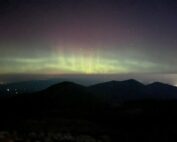Sweat + Summit + Sunrise = Science!
2014-09-26 19:17:00.000 – Kaitlyn O`Brien, Weather Observer/Education Specialist
This morning, we observed an interesting phenomenon that frequently occurs on the summit. If you checked in with our Current Summit Conditions shortly after sunrise today, you may have noticed a spike in the temperature graph. While the spike may look like erroneous data, the data is actually correct! Read on to learn why!
We have several different thermometers installed up here on the summit. In addition to the dry bulb thermometer on our sling psychrometer, we also have two mounted thermometers that are protected by radiation shields. These are the thermometers that feed into our database and make up the temperature graph on our Current Conditions page. Shortly after 2AM EDT early this morning, the summit became obscured by fog, and did not clear until just after 6AM EDT. During this time, the radiation shields on the thermometers accrued moisture until the fog lifted, allowing dry air to reclaim the summit for the rest of the day. As the fog dissipated, the moisture on the radiation shields lingered and experienced evaporative cooling as the drier air moved in. If you’re not familiar with what evaporative cooling is, this is exactly the same reason why you initially feel chilly when getting out of the ocean or swimming pool. The water is evaporating off of your skin and depriving you of heat in the process. Another perfect example is sweat. Our bodies sweat to moderate our temperature, and cool us down when we are working hard. After a hard workout on a muggy day, you’ll notice that you do not cool off as quickly as you would if it were a dry day with low humidity. This is because on a high humidity day, the air is already so saturated with moisture that the sweat on your skin will not evaporate quickly, thus making you feel sticky.
It is this same evaporative cooling process that caused the temperature probe to plummet down to near 36 degrees F this morning. Shortly after, the temperature rebounded quickly as a result of sunrise, which occurred at 6:30AM EDT. This is clearly visible in the attached graph, but keep in mind all data times are in EST. Next time you notice a blip on the temperature graph, there may be more to it than erroneous data!
Kaitlyn O`Brien, Weather Observer/Education Specialist
Inside the Weather Room: How Mount Washington Observers Monitor the Atmosphere
Inside the Weather Room: How Mount Washington Observers Monitor the Atmosphere By Karl Philippoff As a weather observer on Mount Washington, we take our hourly observations on the observation deck, usually heading out between
From Weather Observer to Intern, to Observer Again
From Weather Observer to Intern, to Observer Again By Madelynn Smith As I rode in the backseat of our Obs van up the Auto Road for the first time as a full-time employee at
From Mountains to More Mountains
From Mountains to More Mountains: This Time with Stronger Winds By Alyssa Bélanger On the observation deck in high winds. Hello there! My name is Alyssa Bélanger and I am a fall




